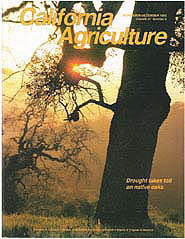All Issues

Drought takes toll on native oaks
Cover:
Although well adapted to periodic drought, populations of three species of native oak suffered setbacks from the severe 6-year drought on the California Central Coast. This blue oak (Quercus douglasii) was photographed in Hastings Natural History Reservation in Carmel Valley.
Photo by Norden H. (Dan) Cheetham
November-December 1993
Volume 47, Number 6
Volume 47, Number 6





